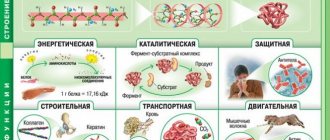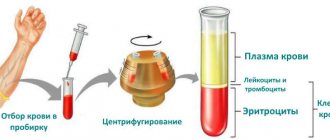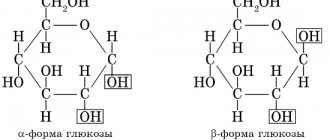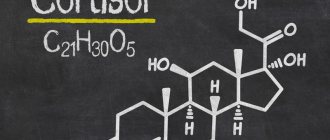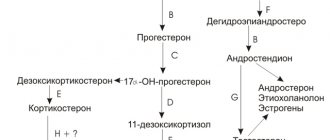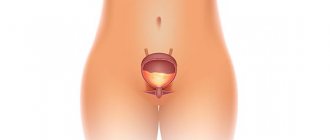To answer the question of free T4 - what kind of hormone it is, you first need to determine what thyroxine is. This biologically active substance belongs to the main forms of thyroid hormones of the thyroid gland and is synthesized by its follicular cells. The production of thyroxine is controlled by the pituitary thyroid-stimulating hormone (TSH). Thyroxine is biologically inactive; in peripheral tissues it is converted into a more active form - triiodothyronine (T3). 1 molecule of thyroxine contains 4 iodine atoms. A significant part of this hormone circulates in the bloodstream in a bound form, in combination with thyroxine-binding globulin. A small part of thyroxine is found in the blood in free form.
Thyroxine is one of the thyroid hormones that plays an extremely important role in the body.
Free thyroxine (free T4, free T4, CT4, free tetraiodothyronine) is a fraction of the thyroid hormone circulating in the blood that is not bound to proteins and accounts for approximately 0.03% of the concentration of total thyroxine. The free fraction of thyroxine most adequately characterizes the hormonal function of the thyroid gland.
What is the free T4 hormone responsible for in women and men?
There are no specific target cells for this hormone in the body; thyroxine affects all tissues of the human body. It is able to penetrate the membrane and connect with the receptors of any cells, and also accumulate in the tissues of the thyroid gland. The mechanism for the release of this substance from the thyroid gland is regulated by its concentration in the blood.
Among the main tasks of this hormone in the body is the activation of metabolic processes; it is necessary to ensure the development and differentiation of all cells of the body.
In the first three months of pregnancy, the hormone plays an important role in the development of the fetus - it takes part in the development of its nervous system and some other processes.
In addition, it performs the following functions:
- controls the growth and development of the body;
- increases body temperature;
- stimulates protein synthesis;
- increases heart rate;
- thickens the uterine mucosa in women;
- stimulates vitamin metabolism;
- reduces cholesterol and triglyceride levels in the blood;
- increases calcium excretion in urine;
- increases oxygen consumption by tissues (except the brain, spleen, testicles in men).
What is thyroxine
Hormones T4 and T3 contain iodine, and the numbers in the name indicate the number of iodine atoms in their composition.
Thyroxine occupies up to 80% of the total amount of hormones produced in the thyroid gland, while its activity is approximately 10 times lower than the activity of T3. The predominant amount of T3 hormone is produced from T4 hormone directly in the body tissues.
Thyroxine has a simple chemical structure and is easily synthesized artificially. Laboratory analysis for T4 content is often prescribed and has good reliability.
The functions of thyroxine are of high importance for regulating many processes in the body. Lack of T4 production, as well as its excess, causes clinical manifestations.
The functions of thyroxine are of high importance for regulating many processes in the body.
What is he responsible for?
Thyroxine affects metabolic processes throughout the body, it penetrates cell membranes and stimulates the synthesis of ribonucleic acid (RNA) molecules.
By activating metabolism, T4 affects the body’s energy balance: it increases body temperature, stimulates tissue growth and development, increases protein synthesis, increases heart rate, improves the absorption of vitamins, and enhances oxidative processes in cells. This hormone is also involved in the functioning of the reproductive system.
Thyroxine affects the processes of breathing, nutrition, digestion, sleep, movement, and muscle function.
Thyroxine affects human sleep and more.
Differences between common and free
After thyroxine is released into the blood, most of it is captured (bound) by a specific protein substance - TSG (thyroxine-binding globulin), which acts as a carrier. In the protein-bound state, the hormone has no activity. A small amount of produced T4 is not captured, remaining in a free state, it is called free thyroxine.
The total T4 level refers to the total amount of free and bound thyroxine.
Free hormones influence processes in the body, therefore, in the diagnosis of thyroid diseases, determining their content in the blood is of great importance. Most often, doctors refer patients for a study of TSH (thyrotropin) and free T4; in simple cases this is enough to exclude or suspect pathology.
Most often, doctors refer patients for a TSH (thyrotropin) test.
Why the T4 hormone may be elevated
A high level of free thyroxine can be observed in inflammatory diseases and neoplasms of the thyroid gland, disorders of the liver, and kidneys. In addition, it can increase in women during pregnancy.
An increase in thyroxine levels can be caused by:
- hyperthyroidism;
- choriocarcinoma;
- multiple myeloma;
- acquired immunodeficiency syndrome;
- hepatitis;
- postpartum thyroid dysfunction;
- obesity.
Radiological contrast agents, oral contraceptives, antiepileptic drugs, insulin use, and large doses of acetylsalicylic acid can increase hormone levels.
Causes
Low T4 levels are observed in the following conditions:
- Primary hypothyroidism. This group includes both congenital and acquired diseases of the thyroid gland (autoimmune thyroiditis, endemic goiter, benign and malignant tumors). Hypothyroidism also develops after extensive resection of the thyroid gland.
- Secondary hypothyroidism. The cause of this condition may be thyrotropinoma, inflammation and injury of the pituitary gland, Sheehan syndrome.
- Tertiary hypothyroidism. Its development is caused by inflammatory and post-traumatic processes in the hypothalamus.
- Lack of iodine in the diet, caused by living in regions deficient in this element, addiction to strict diets, and prolonged fasting.
- Occupational pathology associated with contact with lead.
- Drug addiction (use of heroin).
- Taking certain medications (including steroid hormones, anticonvulsants, anabolic steroids, oral contraceptives, NSAIDs, antifungals, lithium salts).
Why might T4 be low?
After age 40, thyroxine levels usually begin to decrease in both men and women. A temporary decrease in hormone levels is possible with excessive physical activity. Surgical removal of the thyroid gland leads to a permanent decrease in thyroxine levels.
In addition, when a low concentration of thyroxine is detected, it means that one of the following pathological conditions may be present:
- hypothyroidism;
- loss of protein (with diseases of the gastrointestinal tract, nephrotic syndrome);
- Itsenko-Cushing's disease;
- pathology of the hypothalamus and/or pituitary gland;
- iodine deficiency in the body.
Illicit drugs and medications from the following groups can reduce hormone levels:
- glucocorticoids;
- antibiotics;
- anticonvulsants;
- anabolic steroid;
- non-steroidal anti-inflammatory drugs;
- diuretics;
- anti-tuberculosis;
- beta blockers.
Analysis transcript
Deciphering the analysis requires a qualified approach and can only be done by specialists. Interpretation of the tests occurs after a thorough assessment of the patient being studied, concomitant pathologies, and medical history (taking medications that affect the level of the T4 hormone).
Free T4 is tested in any accredited laboratory.
Studies are prescribed before and after surgical interventions on the thyroid gland, after hormonal treatment, for infertility, to identify various diseases. T4 analysis is indicated for children with increased mental stress, for preventive adjustment of iodine levels in the body.
Free T4 hormone is taken into account in other diseases of the endocrine system, in professional athletes, as well as for indicators of men's health.
Treatment of diseases of the endocrine system, in particular the thyroid gland, is prescribed only by an endocrinologist. Usually, in order to reduce elevated T4, thyreostatics are recommended. If the T4 level is insufficient, replacement therapy is prescribed, which requires long-term use.
If specific symptoms indicating thyroid disease occur, you should immediately contact a specialist for further medical examination.
T4 levels are above normal
Elevated levels of the hormone in the blood are the result of the following diseases:
- Thyroiditis always causes high T4 levels,
- Diffuse toxic goiter,
- Tumor diseases of the thyroid gland, as a rule, cause the highest level of the hormone in the blood,
- T4 reaches an increased value in obesity,
- TSH - independent thyrotoxicosis,
- Chronic liver diseases,
- Kidney diseases,
- Postpartum thyroid disorders
- Therapy with drugs containing heparin is characterized by increased levels of T4 in the blood,
Free T4 in pregnant women
T4 will be higher than normal in the first trimester of pregnancy up to 13 weeks, and the norm is 12.0-19.5 pmol/l.
In the second trimester of pregnancy, free T4 will be slightly reduced and amount to 9.6-17.0 pmol/l.
In the third trimester of pregnancy it is low relative to the second trimester and amounts to 8.5 - 15.5 pmol/l.
Symptoms of Imbalance
Both under and over activity of the thyroid gland can be accompanied by its enlargement.
Low concentrations of thyroxine are characterized by:
- weight gain;
- dry skin;
- fatigue even with minor physical exertion;
- menstrual cycle disorders in women.
A congenital deficiency of this substance in the body can lead to the development of cretinism in young children, and myxedema in older patients.
If there are signs of hormonal imbalance, you should consult a doctor
With a high level of free thyroxine fraction, the following may be observed:
- tachycardia;
- arrhythmia;
- swelling on the face;
- weight loss;
- sleep disorders;
- exophthalmos;
- tremor of the upper and lower extremities;
- increased sweating;
- feeling of restlessness;
- irritability.
With a long-term elevated level of thyroxine in a person’s blood, calcium begins to be washed out of the bones, which increases the risk of fractures and the development of osteoporosis. If a patient develops hyperthyroidism due to increased production of thyroxine, this may cause the development of heart failure.
Action of thyroxine in the human body
Its main effect is to enhance catabolism, that is, accelerate the processes that occur with the release of energy from the body's reserves.
When taking 200 micrograms of T4 per day, its effect on the human body can be seen quite easily, as the following symptoms will appear:
- the appearance of tachycardia,
- irritability,
- weight loss.
This experiment does not prove the harmfulness of this biologically active substance to the human body, since these symptoms appear only with an overdose. Normally, it is responsible for normalizing metabolism and fat breakdown, regulating the excitability of the nervous system and heart rate.
It should be remembered that tetraiodothyronine is much less active than T3 (triiodothyronine). T3 has three iodine atoms and is formed mainly from tetraiodothyronine. A small amount of it is synthesized by the thyroid gland.
These biologically active substances are called thyroid hormones because they are synthesized by the thyroid gland, while TSH is synthesized in the pituitary gland. This must be taken into account when prescribing therapy for disturbances in the concentration of thyroid hormones in the blood.
Diagnostics
To obtain information about the functioning of the thyroid gland, a thyroxine test is prescribed in conjunction with a laboratory determination of the level of thyroid-stimulating hormone (especially if the level of thyroxine-binding globulin fluctuates during pregnancy, in the case of the use of androgen and estrogen drugs) and triiodothyronine. The main functions in the body are performed by the free fractions of thyroxine and triiodothyronine. The study of antibodies to thyroid peroxidase and thyroglobulin is of diagnostic importance.
Rules for preparing for donating blood for analysis:
- If the patient is taking thyroxine medications, you can donate blood for analysis only before taking it, otherwise a distorted result will be obtained.
- On the day before donating blood, stress and excessive physical activity should be avoided.
- Before analysis, you need to remove fatty foods from your diet.
- It is recommended to donate blood in the morning on an empty stomach (at least 8 hours must pass after the last meal).
Different laboratories may use different research methods, the standards for thyroxine levels in the blood may differ, and in addition, different laboratories may use different units of measurement for the concentration of free thyroxine in the blood (pmol/l, ng/dl, ng/l, pg/ml and etc.), which should also be taken into account. If it is necessary to repeatedly determine thyroid function indicators, it is best to take tests at the same medical institution.
Deviations in readings
Practice shows that to describe the full picture, it is advisable to undergo analysis in two independent laboratories. The fact is that the sensitivity of the methods and the conscientiousness of the laboratory assistant can lead to a distortion of the real results, which has happened more than once. If several independent studies confirm each other's results, then the reasons should be understood.
A reduced level of the hormone indicates a decrease in the normal function of the endocrine system and the thyroid gland in particular. This hypofunction is called hypothyroidism.
The occurrence of the disease can occur from other pathologies of the gland. For example, if thyrotoxicosis has previously been observed, which is traditionally treated with radioactive iodine. Surgery and removal of the thyroid gland also lead to deviations of thyroxine from normal.
The most common cause is thyroiditis. The disease is characterized by the production of antibodies that destroy follicles with thyroglobulin. Thus, the reserves are destroyed and T4 does not enter the blood.
The decrease can also be caused by closed craniocerebral injuries, as they affect the functioning of the hypothalamus. The latter, in turn, regulates the production of thyroid hormones.
Oral contraceptives can cause thyroxine to be significantly lower than normal. Since many of these drugs are also hormonal in nature, their effect on the endocrine system manifests itself differently in each body. Before prescribing this type of contraceptives, it is necessary to take a blood test.
Hypothyroidism can also result from low-protein diets or a lack of iodine-containing foods in the diet. Statistics show that this deviation is typical specifically for people living far from the sea. Therefore, the amount of protein consumed should be rationed daily, and the amount of iodine can be replenished with fortified salt.
Free T4: normal
In women, the concentration of thyroxine in the blood is usually slightly lower than in men. During normal thyroid function, the content of free T4 in the blood depends on the level of thyroxine-binding globulin.
Daily fluctuations are typical. Thus, the highest level of the hormone is observed between 08:00 and 12:00, the lowest – in the period from 23:00 to 03:00. There are also seasonal changes in the level of free T4 in the blood: the maximum concentration is between September and February, the minimum value is in the summer months.
The table shows the normal values of the free fraction of thyroxine in the blood.
| Patient category | Reference values, ng/dL |
| Non-pregnant women and men | 0,89–1,76 |
| Pregnant women (1st trimester) | 0,86–1,87 |
| Pregnant women (II-III trimester) | 0,64–1,92 |
The endocrinologist should decipher the test result. The treatment regimen (if necessary) is selected depending on the cause of the pathology. Self-medication is unacceptable.
How to take a T4 test correctly
When free T4 is elevated, symptoms of hyperthyroidism appear. Reasons to see a doctor are:
- dyspnea;
- causeless arrhythmia;
- pain in the chest area;
- rapid pulse.
To determine the level of the hormone, a biochemical blood test is prescribed. To get a complete picture of the condition of the thyroid gland, the level of two hormones is determined at once - thyroxine and thyrotropin. Depending on the symptoms and indications, hormonal tests are prescribed in other combinations. If the patient does not have pronounced signs of the disease, free fractions of hormones are examined.
If the endocrinologist recommends testing for TSH and T4, the level of free thyroxine should be determined. The results of hormonal studies will most accurately reflect the state of the thyroid gland.
The testing must be preceded by preparation that excludes serious errors in the results. To do this you need:
- stop drinking alcohol and smoking 3-4 days before the procedure;
- avoid excessive physical activity and stress;
- stop taking vitamin-mineral complexes;
- Do not eat food 12 hours before the test.
Tetraiodothyronine concentrations may be elevated due to the following medications and steroids:
- aspirin;
- valproic acid;
- levothyroxine;
- diazolin;
- methadone;
- phenytoin;
- furosemide;
- clofibrate;
- tamoxifen, etc.
Therefore, endocrinologists advise stopping using medications 4 days before the examination.
Treatment
The basis of drug therapy for low thyroxine levels is HRT (hormone replacement therapy). Its meaning is that the patient is prescribed the missing hormones. Most likely, the patient will have to take these drugs for the rest of his life, since the body cannot independently replenish or synthesize the missing hormones.
If a low free T4 is caused by a lack of iodine, then the patient is prescribed iodine-containing drugs. After a course of treatment they look at the results. If free T4 remains low, then hormonal medications are prescribed.
If you suspect that you are developing thyroid disease, do not wait for significant symptoms to appear; contact an endocrinologist as soon as possible. Timely prescribed treatment will avoid the development of severe forms of thyroid pathologies and consequences for the body.
Thyroxine during pregnancy
Listed above are the general aspects of the influence of T4 on the female body. During pregnancy, the hormone has additional effects on the fetus and the mother's body:
- Helps supply the fetus with the substances necessary for development;
- Improves the synthesis of protein and acids by the mother’s body;
- Preserves metabolism; women with normal T4 levels gain less weight during pregnancy;
- Preserves a woman’s mental activity during the perinatal period, when her resources are rapidly depleted (accelerates the transmission of impulses between neurons);
- Increases cell heat transfer;
- Strengthens the peristalsis of the small intestine, thereby maintaining proper digestion; Stabilizes heart rate, strengthens blood vessels.
By itself, thyroxine is passive. However, when meeting iodine molecules, T4 is converted into powerful hormonal substances. They have the listed effect on the woman and the fetus.
Excess hormone
There are diseases and pathological conditions in which free T4 is elevated. The concentration of the hormone increases with liver diseases in the chronic stage, nephrotic syndrome, thyroid adenoma, the formation of toxic goiter, myeloma, etc. Deviations in the functioning of the thyroid gland after childbirth are possible. Also, some medications can increase T4 levels (Aspirin, Danazol, Furosemide, Propranolol, etc.).
The causes of excess T4 in the body may be non-medical. Stressful situations and physical activity can increase the amount of thyroxine in the body. In some cases, the blood serum contains a high concentration of the hormone; this is a temporary phenomenon.
The elevated thyroxine level will return to normal in a few days.
Therefore, before donating blood for analysis, doctors recommend not exposing the body to stress, physical or emotional.
When free T4 thyroxine is elevated, this condition can manifest itself physically. Patients become hot-tempered and even aggressive, there is sweating, arrhythmia, trembling in the arms and legs. Weight may drop sharply due to accelerated breakdown of fats.
What other factors affect the thyroid gland?
Having received results on the content of free T4 during pregnancy, do not panic if an abnormality is detected. The production of hormones in the female body is not static. It is constantly changing, subject to many factors:
- Woman's age;
- Duration, current phase of the menstrual cycle;
- Different trimesters of pregnancy;
- Taking medications;
- Emotional condition;
- Quality of nutrition, diet.
Even events that seem insignificant influence the behavior of the thyroid gland. For example, if a woman eats a low-fat diet, her T4 levels will increase.
Table of T4 norms in the blood of women
The free thyroxine index parameter is defined as the free thyroxine concentration multiplied by thyroid hormone uptake, resulting in a measurement of unbound thyroxine-binding globulins. A T4 blood test is a test of thyroid function to detect hyperthyroidism. With age, thyroxine levels decrease.
Table of norms for free thyroxine in women by age.
| Age in years | Norm in µmol/l |
| 18 , 50 | 0,9 , 11,8 |
| 50 , 60 | 0,7 , 5,4 |
| 60 , 70 | 0,4 , 3,5 |
| Over 70 | 0,4 , 2,4 |
During pregnancy, thyroxine is produced most actively and reaches its highest concentration.
Table of norms for total and free thyroxine in pregnant women.
| Patients | T4, general norm, nmol/l | T4, free norm, pmol/l |
| Adult women | 71 , 143 | 11 , 21 |
| Pregnant women up to 4 months | 77 , 231 | 12 , 19,5 |
| Pregnant women from 4 to 7 months | 75 , 230 | 18 , 19 |
| Pregnant women from 7 months until birth | 77 , 230 | 8,2 , 17 |
The test results in themselves are not diagnostic; to determine the causes of excess or deficiency of T4 thyroxine (if present), doctors conduct additional tests.
- Normal T4, normal T3 and high TSH: mild hypothyroidism.
- Low T4, low T3 and high TSH: hypothyroidism.
- Normal T4, normal T3, low TSH: mild hyperthyroidism.
- High T4, high T3, low TSH: hyperthyroidism.
Most clinical laboratories use a measurement method that detects only the free hormone (which is the active form), avoiding the problems of interpreting total hormone concentrations.
If T4 is low
A downward deviation from the norm in free thyroxine during pregnancy is also a signal of incipient diseases. Most of these diseases are related to hormonal conditions and the thyroid gland. As in the previous case, a slightly reduced thyroxine can be considered normal and attributed to external factors affecting the woman’s health.
A significantly reduced free T4 can be judged by the following symptoms:
- Poor health, general weakness, lethargy, malaise;
- Drowsiness even during daylight hours;
- Strong and rapid weight gain, not associated with fetal growth or greatly exceeding the norm;
- Constipation;
- Swelling of the face, limbs;
- Bradycardia.
I strongly advise against missing out on the situation. Deviations up or down not only have a bad effect on the well-being of the expectant mother. They threaten pathologies in fetal development and serious endocrine diseases for women.
If pathology is detected, treatment is indicated aimed at bringing the amount of T4 closer to normal. It is recommended to check the amount of the hormone before conception, in preparation for pregnancy. The impact on a woman’s hormonal levels during the perinatal period is dangerous for both the woman and the fetus.
Recommendations before taking the test
In order for the results after analyzing venous blood for T4 to be accurate, it is important to follow simple recommendations:
- three days before the test, you need to stop taking medications containing iodine;
- You should stop using hormonal medications for a month;
- during the day you need to exclude physical or emotional stress;
- You should not drink or smoke a few hours before the test.
Blood is donated on an empty stomach; you are only allowed to drink water. It is advisable to just sit for half an hour and calm down immediately before taking the test. If a set of tests is prescribed, then blood for hormones is donated first. As a result, each patient receives the results with a transcript.
Normal for men by age
Optimal thyroxine levels change throughout life. The fluctuations are small, but there are reference limits for each age. After 45 years, the secretion of thyroid hormone is less active, but this is considered normal.
Acceptable level of free T4 (measurement in nmol/l):
- boys from 4 to 12 months – from 76 to 203;
- child age from one to six years – from 76.6 to 189;
- boys 7 to 12 years old – from 77.1 to 178;
- teenagers and young men 13 to 20 years old – from 76.1 to 170;
- men from 20 years old and mature age - from 59 to 135.
Important! Determination of thyroxine levels during diagnosis and treatment should be carried out in one laboratory. Medical centers use equipment of different categories; they determine T4 in several units
To avoid confusion and inaccurate indicators, you need to choose a high-level medical institution. Optimally, use new generation equipment: blood analyzers for conducting studies using the ICL (immunochemiluminescence) method.
Reduced thyroxine T4
Hormonal balance is a close relationship between the body's internal secretion products. At the same time, a change in the concentration of one of the components of this relationship can affect both other components of the balance and affect health. Thyroxine (T4) is an important building block of hormonal balance. T4 is a hormone produced by the follicular cells of the thyroid gland and is involved in the regulation of many vital processes.
The main function of thyroxine is to control the energy metabolism of the human body. The concentration of this hormone in the blood may be reduced, which leads to the development of diseases and disruption of the overall hormonal balance, requiring treatment. In this article we will look at what causes a lack of thyroxine, what it leads to and how to deal with it.
If the level of free or total thyroxine is below normal, it is called hypothyroidism. In most cases it is accompanied by a number of symptoms. These symptoms include the following:
- weight gain (occurs due to disruption of catabolic processes);
- dry skin;
- heart rhythm disturbances (in acute forms can lead to ischemia of the heart muscle);
- fast fatiguability;
- hair loss;
- disruption of the digestive system (diarrhea);
- in children, free and total T4 below normal can cause retardation in mental and physical development (cretinism);
- increased swelling.
When the hormone level is low, similar symptoms are observed in combination. If you find one of them in yourself, then you should listen carefully to your own body.
If you have a predisposition or risk of developing a hormonal disorder, you should definitely consult an endocrinologist and undergo an examination.
Identifying disorders at an early stage, especially in children and during pregnancy, helps to respond to a developing disease in a timely manner and begin treatment on time.
Deficiency of free and total thyroxine in the blood is characterized by a number of reasons:
- Primary hypothyroidism. This disease is caused by a malfunction of the thyroid gland, which reduces the T4 content below reference values. Primary hypothyroidism occurs due to various factors, including iodine deficiency, cancer, surgical interventions, autoimmune pathologies and others. Most often, symptoms of this disease occur among women over 65 years of age and in residents of regions remote from the sea.
- Endemic goiter. This pathology is characterized by a significant enlargement of the thyroid gland. The disease in most cases occurs against the background of iodine deficiency in the body.
- Autoimmune thyroiditis. This is a chronic autoimmune disease, the origins of which are still unclear. In the early stages, autoimmune thyroiditis occurs without symptoms, which significantly reduces the likelihood of timely detection of the disease. In later stages it results in hypothyroidism.
- Surgical intervention (resection of the thyroid gland). Some pathologies force the doctor to prescribe partial or complete removal of thyroid tissue, followed by a long course of hormones.
- Secondary hypothyroidism. This disease, unlike primary hypothyroidism, is characterized by disruption of the pituitary gland or hypothalamus. This entails hormonal imbalance and reduces the level of free thyroxine below normal.
- Various oncological benign or malignant neoplasms can lead to pathological production of T4 below the natural intensity.
- Iodine deficiency. As mentioned earlier, insufficient iodine intake from food stimulates many thyroid diseases.
- Lead poisoning.
- A separate risk group for hypothyroidism includes heroin addicts. Drug use leads to a significant disruption of internal homeostasis.
- The use of certain medications reduces thyroxine: anabolic steroids, anticonvulsants, thyreostatics, oral contraceptives, lithium preparations and others.
Separately, it is necessary to focus on the low free hormone in the blood during pregnancy. During pregnancy, the concentration of free thyroxine is very important for both the expectant mother and the child.
During pregnancy, thyroxine affects the development of the fetal nervous system. If the amount of the hormone in a woman is reduced, this can lead to mental and physical developmental delays.
An additional problem is that during pregnancy there is an intensification of all physiological processes in the mother’s body. This leads to an increase in the concentration of the hormone in the blood.
Thus, if a woman develops hypothyroidism, it is not always easy to diagnose it by external symptoms. An analysis of free and total T4 when pregnancy is detected is mandatory. It can also be done when planning a pregnancy. Thyroxine below reference values can be a source of difficulties with conception, including infertility.
When a clinical analysis reveals a T4 level below normal levels, you should definitely consult a doctor to prescribe treatment. Independent attempts to increase thyroxine with hormonal medications and folk remedies may not only not bring the desired result, but also cause harm. You should not ignore your own health, especially when planning a pregnancy.
As a preventive measure, it is recommended to regularly take blood tests, consult a doctor, monitor symptoms of possible diseases and lead a healthy lifestyle. This tactic reduces the risk of developing the disease and increases the likelihood of its timely detection.
Norms for thyroxine levels during pregnancy
The hormone is found in the blood of men and women; its normal amount is considered to be 11-21 Pmol/l. Some medical institutions have adopted slightly different standards, but this is the generally accepted one. Free T4 levels during pregnancy depend on the current trimester:
- During the first trimester, T4 levels are close to normal. Slight excesses of the upper threshold are allowed. This is due to the fact that the female body is just getting used to the pregnant state; activation of the control of thyroxine production has not yet begun.
- By the second trimester, the hormone levels decrease. A level of 9.5-19 Pmol/l is considered normal.
- In the third trimester, the amount of T4 is even lower, 8.2-17 Pmol/l.
It is important to understand that total thyroxine levels differ from free thyroxine. Total T4 also decreases during pregnancy, but its content is higher and expressed in other units. When reading the test results, these indicators should not be confused.

